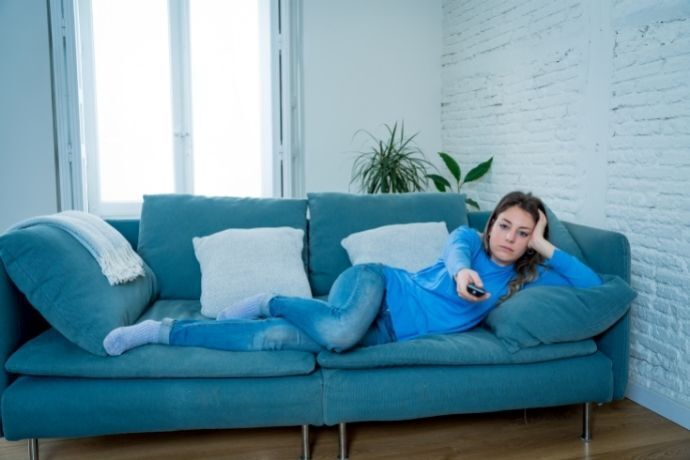Table of contents
Do you know the consequences of a sedentary lifestyle?

Characterized by a partial or even total lack of physical activity, a sedentary lifestyle affects people of all age groups, ethnicities and social classes. In fact, the excuse for most of these people is usually identical: a combination of lack of time and laziness.
However, combating a sedentary lifestyle is essential, because sports and physical exercise in general are indispensable for keeping the body and mind healthy and fully functioning.
All barriers must be overcome, as the body needs to move in order to avoid the onset of chronic diseases such as diabetes, hypertension, obesity and cardiovascular disease. Here's everything you can do to improve your quality of life immediately.
Understanding more about a sedentary lifestyle

Although it is widely known that a sedentary lifestyle is harmful to health, many people still resist practicing physical activity on a regular basis. Find out everything you need to know about this lifestyle, which is making many people sick all over the world.
What is a sedentary lifestyle?
Sedentary behavior can be defined as the total or partial absence of physical activity, directly linked to a long period or even the whole day sitting, reclining, lying down or in any situation that has a very low energy expenditure.
Research suggests that only 21% of adults are meeting global physical activity guidelines. Another worrying point is that less than 5% of the population does at least 30 minutes of physical exercise a day.
By the way, many people believe that you have to practice a high-intensity sport, but just going for a walk is enough to get your body moving on a daily basis and leave sedentary lifestyles behind.
Types of sedentary lifestyle
According to experts, a sedentary lifestyle can be divided into 4 levels, which vary according to the intensity and frequency of the few daily activities performed by the individual.
Some doctors use a kind of formula to differentiate between levels of inactivity, a calculation that takes into account the amount of energy a person expends compared to their body mass index (BMI).
Thus, if the result is lower than 1.5 or if the individual does less than 150 minutes of physical exercise during the week, they are considered sedentary. Find out more about each level of sedentariness below.
Sedentary lifestyle level 1
Level 1 of a sedentary lifestyle is considered to be the least serious of all. At this level, individuals don't do any physical activity of average intensity. In addition, intense exercise doesn't even cross their minds.
It's safe to say that the only activity they do occasionally is walking to the supermarket, the bakery or the pharmacy. However, even if they do walk, they don't get anywhere near 150 minutes of exercise a week.
Sedentary lifestyle level 2
Considered to be the most common level of sedentary lifestyle, level 2 covers a large number of people. This is because it includes people who always travel by car.
Another group that belongs to level 2 are those who do minimal walking within their own condominium or yard. Walks outside the residential environment are very rare.
What's more, supermarket shopping, for example, is carried by the trolley to the car. In other words, there's no weight loading.
Sedentary lifestyle level 3
At level 3 of sedentary lifestyle, you could say that the motto is "never make any physical effort, avoid it as much as possible." Therefore, people in this category don't go for walks, only take the elevator or escalator, and only carry weights as a last resort.
These people sit or lie down practically all day. They also travel by car and hate doing tasks that require a lot of standing.
Sedentary lifestyle level 4
The most serious of all, level 4 of sedentary lifestyles is when a person has a very high level of inactivity. Therefore, it is also the one that poses the greatest health risks.
At this level, the individual spends the whole day sitting or lying down, getting up only to go to the toilet or get food from the kitchen. It can be said that they can't remember the last time they did any physical activity, even light-intensity ones such as walking.
How important is physical activity for health?
Physical activity is extremely important for all age groups, as it is the best way to keep your body and mind healthy and to improve your quality of life.
Another important point is that physical exercise is an essential tool when it comes to preventing and combating chronic diseases. Individuals who may suffer or already suffer from type 2 diabetes and high blood pressure, for example, benefit from regular exercise.
However, with the hustle and bustle of everyday life and technological facilities, physical activity is being pushed aside and is hardly considered a priority. Cars, escalators, elevators and computers bring more and more convenience and, with it, inactivity.
It is worth remembering that physical activity is any movement of the body generated by muscular contraction that stimulates an increase in energy expenditure above the levels that the individual has at rest.
Social isolation and a sedentary lifestyle
With the social isolation caused by the coronavirus pandemic, sedentary lifestyles have taken a leap forward, because gyms and studios such as yoga and pilates have been closed for a long time.
As a result, many people stopped exercising because the extra time at home was used in other ways, or it even became a challenge, since the desire to eat all day was constant, but the desire to exercise was minimal. When a person is isolated, they lack the motivation of their teachers, trainers and colleagues, which further encourages a sedentary lifestyle
Global levels of physical inactivity
According to the WHO (World Health Organization), a sedentary lifestyle is considered to be the fourth biggest risk factor for mortality in the world, which is why it has become a public health issue.
According to the WHO, around 70% of the world's population suffers from this condition, which is spreading rapidly across the planet. Brazil, in fact, ranks fifth in the world for the number of sedentary people.
To give you an idea of the consequences of this lifestyle, data from 2017 revealed that the profile of Brazilians with a chronic disease associated with a lack of physical activity is increasing. Approximately 7.4% of the population has diabetes, 24.5% hypertension and 20.3% are obese.
The main consequences of a sedentary lifestyle

Recent research is confirming that a sedentary lifestyle poses many health risks. Obesity, type 2 diabetes, cardiovascular disease and reduced life expectancy are the most visible consequences of a sedentary lifestyle. Find out more below.
Lack of mood and energy
There are many habits that can lead to a lack of mood and energy, making you feel down and tired. Although many people think it's normal to feel this way, you should know that it could be related to a much bigger problem, such as a sedentary lifestyle.
Just as too much physical activity can lead to a state of extreme lack of energy, the absence of exercise can cause the same effect. This is because constant rest means that the body is unable to promote good circulation, resulting in fatigue.
Excessive tiredness
It may sound strange, but sedentary people suffer from excessive and constant tiredness because their metabolism slows down due to a lack of physical activity. When exercising, the body releases endorphins, serotonin and dopamine, hormones that increase mood and well-being, both physical and mental.
In addition, these compounds reduce tiredness, even after high-intensity activity, so a sedentary lifestyle causes a drop in the amount of these hormones, leading to excessive tiredness.
Lack of muscle strength
Lack of muscle strength is one of the biggest negative consequences of a sedentary lifestyle, as muscles are not stimulated, end up weakening and may even atrophy. People often imagine that performing everyday tasks, such as sweeping the house and hanging out the washing, is enough to activate all the muscles, but this is very little.
In addition, it's worth noting that older people need to be more careful with reduced muscle mass, as this leads to a greater risk of injuries and falls.
Loss of flexibility
Sitting for a long time, as sedentary people often do, causes tension in the lower back and hips. This tension leads to muscle stiffness, which consequently makes it very difficult for the blood to flow naturally.
Another negative aspect of this lifestyle is the weakening of the abdomen and glutes.
Joint pain
A very common symptom of a sedentary lifestyle, joint pain is usually caused by excessive weight gain, which puts an enormous strain on bones and joints, especially the knees.
Another point that deserves attention is the decrease in bone density caused by a lack of physical activity. When the bones are weaker, the joints suffer a lot, leading to injuries and even fractures.
Fat accumulation and weight gain
One of the most visible consequences of a sedentary lifestyle is the increase in body weight, which poses many health risks. With a lack of body movement, it is extremely common for people to gain a few extra pounds.
This is unsatisfactory because, along with weight gain, comes the accumulation of fat, which is extremely harmful, especially if it happens around the organs.
Slowed metabolism
When you're sedentary, your metabolism slows down, especially when compared to someone who exercises regularly.
This situation is bad because thermogenesis (our body's ability to regulate its internal temperature according to the conditions of the external environment, by burning energy), which should be induced by exercise, doesn't happen. As a result, calorie expenditure doesn't occur either.
Increased risk of disease
A sedentary lifestyle can increase the risk of developing a number of chronic diseases, since physical activity is essential for the body to function properly.
Some diseases linked to a sedentary lifestyle are: high blood pressure, overweight, obesity, increased triglycerides, lower good cholesterol (HDL), metabolic syndrome, type 2 diabetes and insulin resistance.
What's more, these diseases can have a domino effect, leading to even more serious problems such as cancer.
Weakened immune system
Lack of physical activity can damage the immune system, weakening it. Research on adults has shown that moderate-intensity exercise stimulates the production of the body's defense cells.
In addition, it has been proven that people who exercise regularly, even to a lesser extent, have a better immune response to colds and flu, for example. Interestingly, a sedentary lifestyle can even undermine the protection provided by vaccines, as the antibodies are not able to destroy invaders as easily.
Increased risk of anxiety and depression
It can be said that a sedentary lifestyle has a very negative, even devastating effect on mental health. A study of approximately 10,000 participants associated a lack of physical activity with an increased risk of developing any type of psychological disorder.
According to this study, sedentary behavior leads to a great increase in the chances of the individual showing symptoms of anxiety and depression. In addition, problems with self-esteem, self-image and stress are frequent.
Sleep disorders
When something isn't right in our body, it gives signals through sleep, so a sedentary lifestyle can lead to various disorders that cause a bad night's sleep.
Insomnia and apnea are the most common problems in this case, because the production and release of neurotransmitters responsible for regulating sleep, such as serotonin, noradrenaline and dopamine, is reduced. In addition, the respiratory muscles can become weak, which makes it difficult for air to pass through and causes snoring.
Reduced life expectancy
According to the WHO (World Health Organization), a sedentary lifestyle is one of the ten leading causes of death worldwide. It is estimated that 2 million people die from a sedentary lifestyle in a year.
The figure is extremely high, since for every hour a person spends sitting down, their life expectancy is reduced by 21 minutes. Therefore, it can be said that a person who spends six hours a day sitting down has their life expectancy reduced by 5 years.
Other information about sedentary lifestyle and physical activity

The only way to get rid of a sedentary lifestyle is to radically change your habits, which includes an exercise routine. Here's how to incorporate physical activity more easily into your daily life.
What is the daily recommendation for physical activity?
The daily recommendation for physical activity involves 3 runs or 30-minute walks per week. Another option is to do 2 30-minute sessions of strength training exercises per week.
However, the indication varies according to the age and physical fitness of the individual. Check out what each group can do:
Children and teenagers (5 to 17 years old): at least 60 minutes of moderate to vigorous intensity physical activity a day. Give preference to aerobics at least 3 times a week;
Adults (18 to 64 years): 150 to 300 minutes of moderate-intensity aerobic physical activity per week, or 75 to 150 minutes of intense aerobic physical activity per week;
Elderly (65 years and over): can follow the same recommendations as adults, but they need to alternate with muscle-strengthening exercises on 2 or more days of the week;
Pregnant and postpartum women: at least 150 minutes of moderate-intensity aerobic activity during the week. However, it is always advisable to consult your doctor before starting any type of exercise.
Benefits of physical activity
As the human body is made to move, it shouldn't stand still, which means it needs physical activity to prevent and treat illnesses, as well as to keep the body functioning properly.
Exercise brings many health benefits, even preventing the development of more serious illnesses such as cancer. Therefore, including physical activity in your routine will only offer advantages for your body and mind. So don't waste any time and see all the reasons to start exercising right now.
Physical benefits
The physical benefits of exercise include:
- Reduced risk of stroke;
- Lower blood pressure;
- Reduced chances of cardiovascular disease;
- Prevention and control of type 2 diabetes;
- Inhibition of bone density loss, preventing osteoporosis;
- Helps control weight;
- Helps blood circulation throughout the body
- Improves sexual performance;
- Decreased pain levels;
- Helps keep cholesterol levels low;
- Reduced risk of falls and injuries.
Mental benefits
As well as providing physical benefits, exercise also offers many advantages for the mind. Check them out:
- Promotes a feeling of well-being;
- Improves sleep quality;
- It increases the ability to concentrate and focus, as it helps to improve mental conditioning;
- Optimizes memory;
- Improves mood;
- It helps to relax and get rid of the tensions of everyday life, reducing stress;
- Reduces symptoms of depression and anxiety;
- Helps treat ADHD (attention deficit hyperactivity disorder) and PTSD (post-traumatic stress disorder).
How to increase physical activity levels on a daily basis?
With an increasingly busy routine, it's difficult to get rid of a sedentary lifestyle, but it's entirely possible if you just change a few habits:
- Traveling standing up instead of sitting down on public transport;
- Walking to work;
- Take walks during lunch breaks;
- Set reminders on your cell phone to get up every 30 minutes during seated work;
- Take a walk or stand up during breaks from work or study;
- Spend more time doing household chores, such as gardening, for example, which require a lot of movement;
- Answering calls outside the office and walking while talking;
- Replace some television or video game time with outdoor activities;
- If you can't give up the TV, get up and walk around during the commercials;
- Take the stairs instead of the elevator.
Take care when practicing physical activities
Despite being essential for the proper functioning of the body, physical activity requires certain precautions, especially to reduce the risk of injury. See:
- Understand how the activity should be carried out, as well as the execution time;
- Choose exercises that suit your physical condition;
- Respect your body's limits;
- Increase the intensity gradually, never overnight;
- Choose a time and stick to it so as not to lose the stimulus;
- Use appropriate sports equipment;
- Choose safe and comfortable environments.
How to combat a sedentary lifestyle and start practicing physical activity

You may have heard that a more active lifestyle can significantly reduce the chances of chronic diseases, mental health disorders and premature death. So check out everything you need to know before starting your exercise routine.
First of all, make sure you can do physical activities
To get rid of a sedentary lifestyle and start an exercise routine, the first step is to have a check-up. It is essential that you are fully aware of your physical condition, so a consultation with your doctor is very important to clear up any doubts and get the right advice.
If you have been cleared for physical activity, it's worth finding out which exercises are best, the recommended duration and, where possible, nutritional support.
Try to get active first thing in the morning
The best advice is to put laziness aside and do some physical activity in the morning. Even if you feel like sleeping more, getting up early to take care of your health optimizes your day and your body reacts with a lot of energy and pep.
This is because your body is clean as soon as you wake up, making it easier for you to adapt to routine activities. What's more, as it will be your first appointment of the day, the chances of you skipping this "task" are minimal.
Start with lighter activities
One of the best tips for leaving a sedentary lifestyle behind is to start practicing lighter physical activities. Never start the process with something too complicated or intense. Instead, go slowly, progressing little by little.
The advice is to take your time, respecting your body and following its rhythm. Activities such as walking, stretching, going up and down stairs, and strength training such as light weights or resistance bands are the most recommended for beginners.
Have an exercise routine
If your motto is "I'm going to start tomorrow", you're not alone. Most people tend to put everything off until tomorrow and that tomorrow never comes. Therefore, developing an exercise routine is essential if you want your body to finally get out of inertia.
When we create a dedicated space in our diaries for these activities, we can be much more successful in our workouts, with very satisfactory results. Routine is the key to staying consistent and achieving your goals.
Set goals and monitor progress
Before you start your fitness routine, it's worth defining the goals you want to achieve with this new healthy lifestyle. Keep in mind or write down on a piece of paper whether you want to lose weight, tone your body, get in shape for a race, or just want to have good health practices.
These notes, mental or otherwise, will be fundamental in choosing the best physical activity, as well as its frequency. Remember to have a lot of patience with yourself and not to overdo it, start slowly and follow your progress. It will certainly be a fun process.
Doing activities close to home is a great option
A fundamental point for good physical exercise is to do something you enjoy, so if you don't like gyms, invest in activities near your home, outdoors, such as walking, jogging and cycling.
Enjoying exercise is essential if you want to keep your spirits up during your workouts and make natural progress in the sport. Walks around the house, for example, can easily be improved by changing the route, adding a climb or increasing the speed of your steps.
Don't forget to eat healthily
It's very important to combine regular physical activity with a balanced and healthy diet, so it's worth consulting a nutritionist so that they can analyze your physical condition and draw up the ideal menu according to your needs.
Creating eating habits with the right amount of protein, vegetables, fruit and carbohydrates is the key to exercising in the best possible way, helping your body to replenish what was lost during training and, at the same time, burning off the calories ingested.
Another important point is hydration: always drink plenty of water to keep your body functioning properly.
Stop being sedentary and lead a healthier life!

Over time, a sedentary lifestyle can have many unpleasant consequences for your health, such as chronic illnesses and muscle weakness, so it's worth starting physical activity as soon as possible.
What's more, if you've never enjoyed exercise, the good news is that there are countless types of aerobic activities and sports. What's more, if the problem is gyms, you can easily get moving at home, as apps and videos of various disciplines are available on the internet. Always choose something you like and enjoy, so physical activity will never be a burden.

